Electric Vehicle Industry: Value Chain and Product Life Cycle Analysis
VerifiedAdded on 2023/01/11
|10
|2502
|52
Report
AI Summary
This report provides a comprehensive analysis of the electric vehicle (EV) industry, focusing on Volvo Cars as a case study. It begins with an introduction to the growing EV market and the factors driving its expansion. The main body of the report delves into Porter's value chain model, identifying key primary and secondary activities within the EV industry, and evaluating their criticality for future success. The report also examines industry value chains, including supplier, firm, channel, buyer, and disposal/recycle value chains. A PESTEL analysis is conducted to assess the political, economic, social, technological, legal, and environmental factors impacting the EV industry. Furthermore, the report analyzes the product life cycle of electric vehicles, identifying key stages, evaluating the current stage, and predicting future stages. The report concludes by discussing new opportunities and discontinued businesses within the EV sector, highlighting the industry's potential for growth and innovation. The analysis is supported by academic references, providing a robust foundation for the findings.
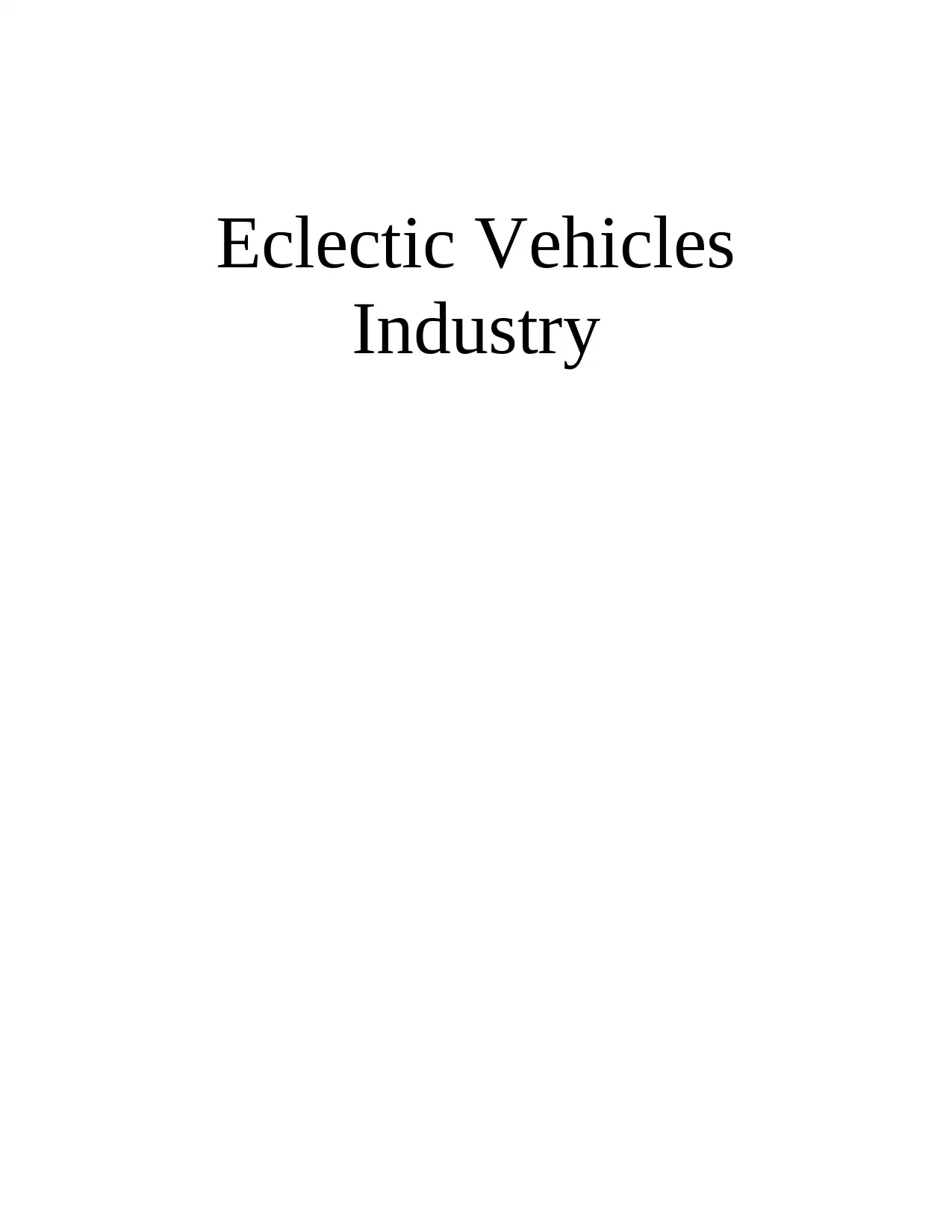
Eclectic Vehicles
Industry
Industry
Paraphrase This Document
Need a fresh take? Get an instant paraphrase of this document with our AI Paraphraser
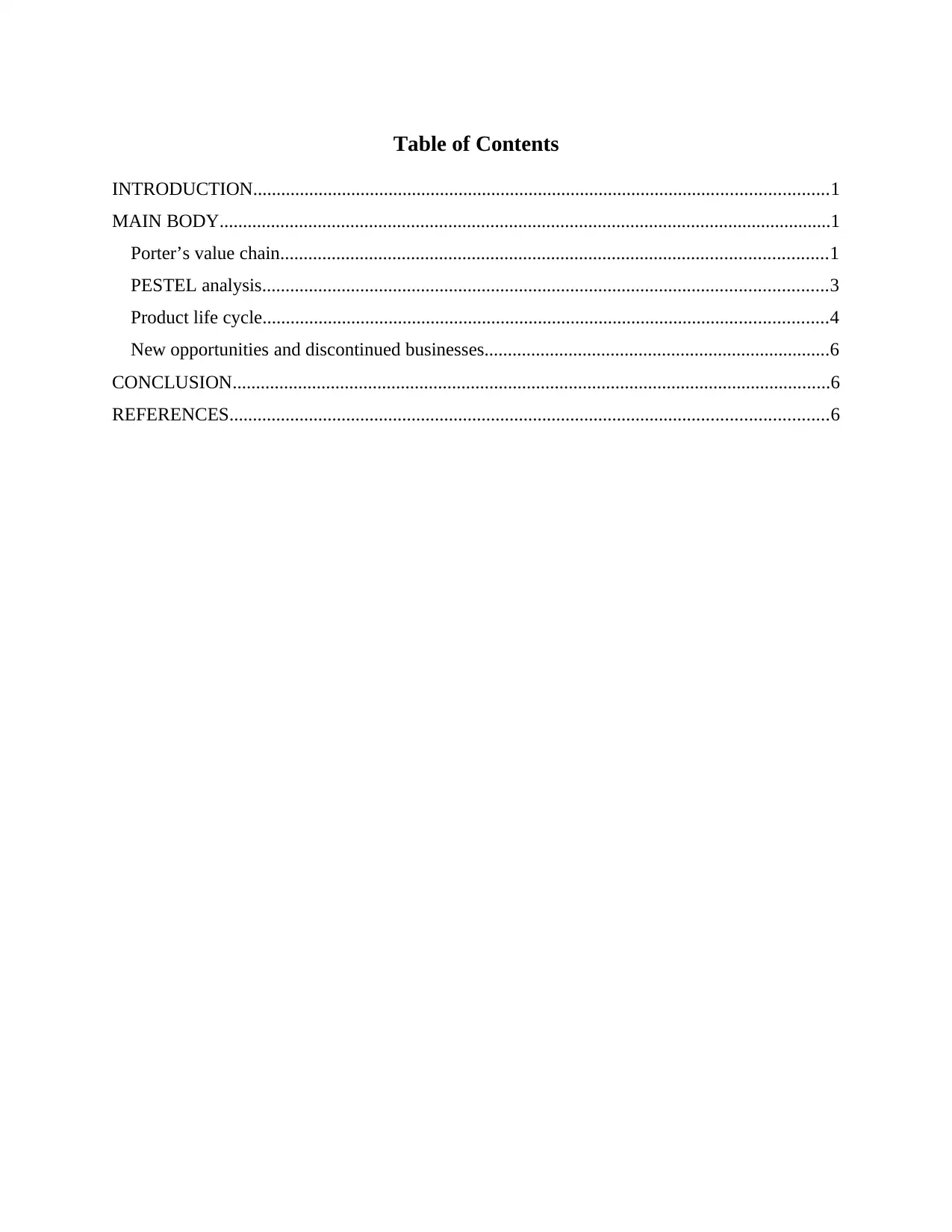
Table of Contents
INTRODUCTION...........................................................................................................................1
MAIN BODY...................................................................................................................................1
Porter’s value chain.....................................................................................................................1
PESTEL analysis.........................................................................................................................3
Product life cycle.........................................................................................................................4
New opportunities and discontinued businesses..........................................................................6
CONCLUSION................................................................................................................................6
REFERENCES................................................................................................................................6
INTRODUCTION...........................................................................................................................1
MAIN BODY...................................................................................................................................1
Porter’s value chain.....................................................................................................................1
PESTEL analysis.........................................................................................................................3
Product life cycle.........................................................................................................................4
New opportunities and discontinued businesses..........................................................................6
CONCLUSION................................................................................................................................6
REFERENCES................................................................................................................................6

⊘ This is a preview!⊘
Do you want full access?
Subscribe today to unlock all pages.

Trusted by 1+ million students worldwide
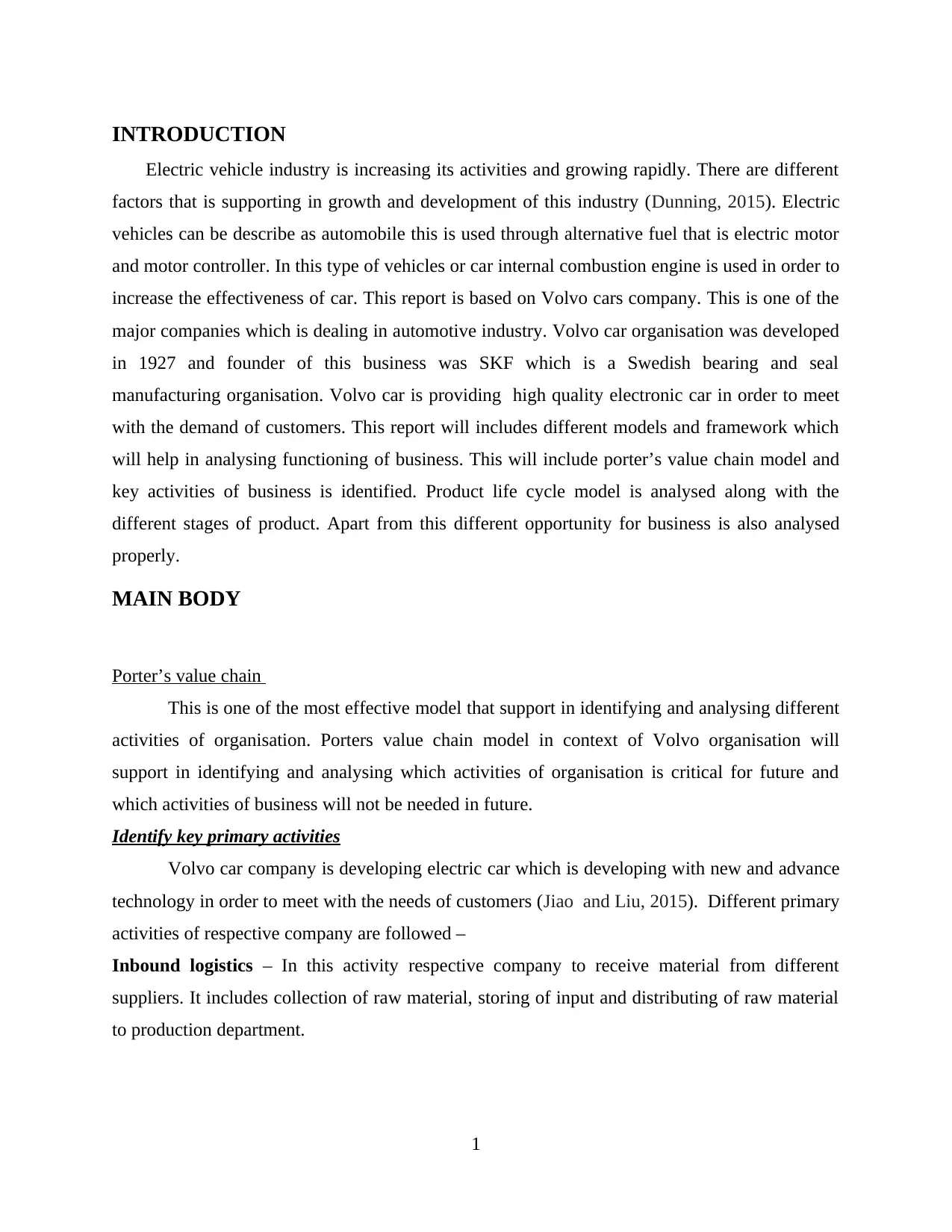
INTRODUCTION
Electric vehicle industry is increasing its activities and growing rapidly. There are different
factors that is supporting in growth and development of this industry (Dunning, 2015). Electric
vehicles can be describe as automobile this is used through alternative fuel that is electric motor
and motor controller. In this type of vehicles or car internal combustion engine is used in order to
increase the effectiveness of car. This report is based on Volvo cars company. This is one of the
major companies which is dealing in automotive industry. Volvo car organisation was developed
in 1927 and founder of this business was SKF which is a Swedish bearing and seal
manufacturing organisation. Volvo car is providing high quality electronic car in order to meet
with the demand of customers. This report will includes different models and framework which
will help in analysing functioning of business. This will include porter’s value chain model and
key activities of business is identified. Product life cycle model is analysed along with the
different stages of product. Apart from this different opportunity for business is also analysed
properly.
MAIN BODY
Porter’s value chain
This is one of the most effective model that support in identifying and analysing different
activities of organisation. Porters value chain model in context of Volvo organisation will
support in identifying and analysing which activities of organisation is critical for future and
which activities of business will not be needed in future.
Identify key primary activities
Volvo car company is developing electric car which is developing with new and advance
technology in order to meet with the needs of customers (Jiao and Liu, 2015). Different primary
activities of respective company are followed –
Inbound logistics – In this activity respective company to receive material from different
suppliers. It includes collection of raw material, storing of input and distributing of raw material
to production department.
1
Electric vehicle industry is increasing its activities and growing rapidly. There are different
factors that is supporting in growth and development of this industry (Dunning, 2015). Electric
vehicles can be describe as automobile this is used through alternative fuel that is electric motor
and motor controller. In this type of vehicles or car internal combustion engine is used in order to
increase the effectiveness of car. This report is based on Volvo cars company. This is one of the
major companies which is dealing in automotive industry. Volvo car organisation was developed
in 1927 and founder of this business was SKF which is a Swedish bearing and seal
manufacturing organisation. Volvo car is providing high quality electronic car in order to meet
with the demand of customers. This report will includes different models and framework which
will help in analysing functioning of business. This will include porter’s value chain model and
key activities of business is identified. Product life cycle model is analysed along with the
different stages of product. Apart from this different opportunity for business is also analysed
properly.
MAIN BODY
Porter’s value chain
This is one of the most effective model that support in identifying and analysing different
activities of organisation. Porters value chain model in context of Volvo organisation will
support in identifying and analysing which activities of organisation is critical for future and
which activities of business will not be needed in future.
Identify key primary activities
Volvo car company is developing electric car which is developing with new and advance
technology in order to meet with the needs of customers (Jiao and Liu, 2015). Different primary
activities of respective company are followed –
Inbound logistics – In this activity respective company to receive material from different
suppliers. It includes collection of raw material, storing of input and distributing of raw material
to production department.
1
Paraphrase This Document
Need a fresh take? Get an instant paraphrase of this document with our AI Paraphraser
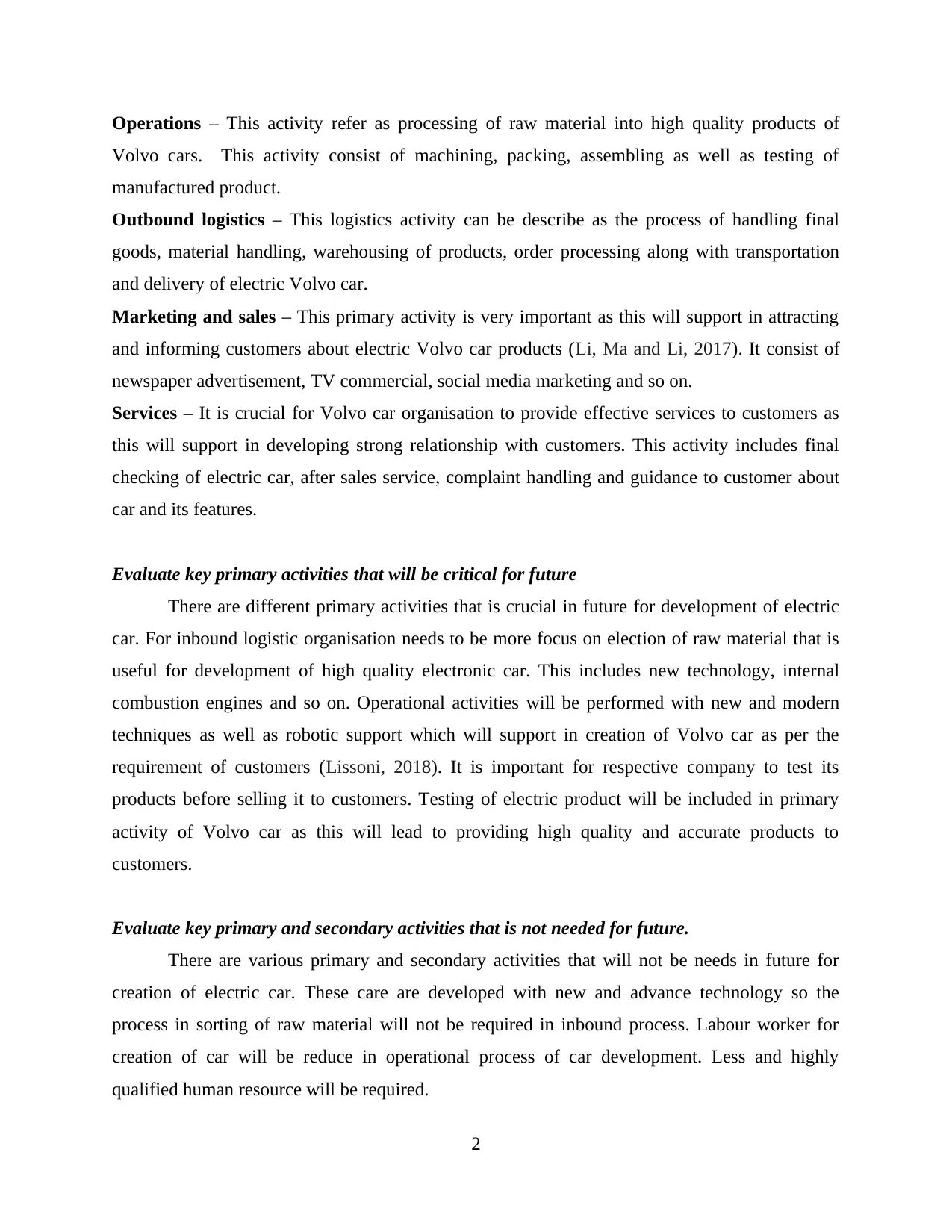
Operations – This activity refer as processing of raw material into high quality products of
Volvo cars. This activity consist of machining, packing, assembling as well as testing of
manufactured product.
Outbound logistics – This logistics activity can be describe as the process of handling final
goods, material handling, warehousing of products, order processing along with transportation
and delivery of electric Volvo car.
Marketing and sales – This primary activity is very important as this will support in attracting
and informing customers about electric Volvo car products (Li, Ma and Li, 2017). It consist of
newspaper advertisement, TV commercial, social media marketing and so on.
Services – It is crucial for Volvo car organisation to provide effective services to customers as
this will support in developing strong relationship with customers. This activity includes final
checking of electric car, after sales service, complaint handling and guidance to customer about
car and its features.
Evaluate key primary activities that will be critical for future
There are different primary activities that is crucial in future for development of electric
car. For inbound logistic organisation needs to be more focus on election of raw material that is
useful for development of high quality electronic car. This includes new technology, internal
combustion engines and so on. Operational activities will be performed with new and modern
techniques as well as robotic support which will support in creation of Volvo car as per the
requirement of customers (Lissoni, 2018). It is important for respective company to test its
products before selling it to customers. Testing of electric product will be included in primary
activity of Volvo car as this will lead to providing high quality and accurate products to
customers.
Evaluate key primary and secondary activities that is not needed for future.
There are various primary and secondary activities that will not be needs in future for
creation of electric car. These care are developed with new and advance technology so the
process in sorting of raw material will not be required in inbound process. Labour worker for
creation of car will be reduce in operational process of car development. Less and highly
qualified human resource will be required.
2
Volvo cars. This activity consist of machining, packing, assembling as well as testing of
manufactured product.
Outbound logistics – This logistics activity can be describe as the process of handling final
goods, material handling, warehousing of products, order processing along with transportation
and delivery of electric Volvo car.
Marketing and sales – This primary activity is very important as this will support in attracting
and informing customers about electric Volvo car products (Li, Ma and Li, 2017). It consist of
newspaper advertisement, TV commercial, social media marketing and so on.
Services – It is crucial for Volvo car organisation to provide effective services to customers as
this will support in developing strong relationship with customers. This activity includes final
checking of electric car, after sales service, complaint handling and guidance to customer about
car and its features.
Evaluate key primary activities that will be critical for future
There are different primary activities that is crucial in future for development of electric
car. For inbound logistic organisation needs to be more focus on election of raw material that is
useful for development of high quality electronic car. This includes new technology, internal
combustion engines and so on. Operational activities will be performed with new and modern
techniques as well as robotic support which will support in creation of Volvo car as per the
requirement of customers (Lissoni, 2018). It is important for respective company to test its
products before selling it to customers. Testing of electric product will be included in primary
activity of Volvo car as this will lead to providing high quality and accurate products to
customers.
Evaluate key primary and secondary activities that is not needed for future.
There are various primary and secondary activities that will not be needs in future for
creation of electric car. These care are developed with new and advance technology so the
process in sorting of raw material will not be required in inbound process. Labour worker for
creation of car will be reduce in operational process of car development. Less and highly
qualified human resource will be required.
2
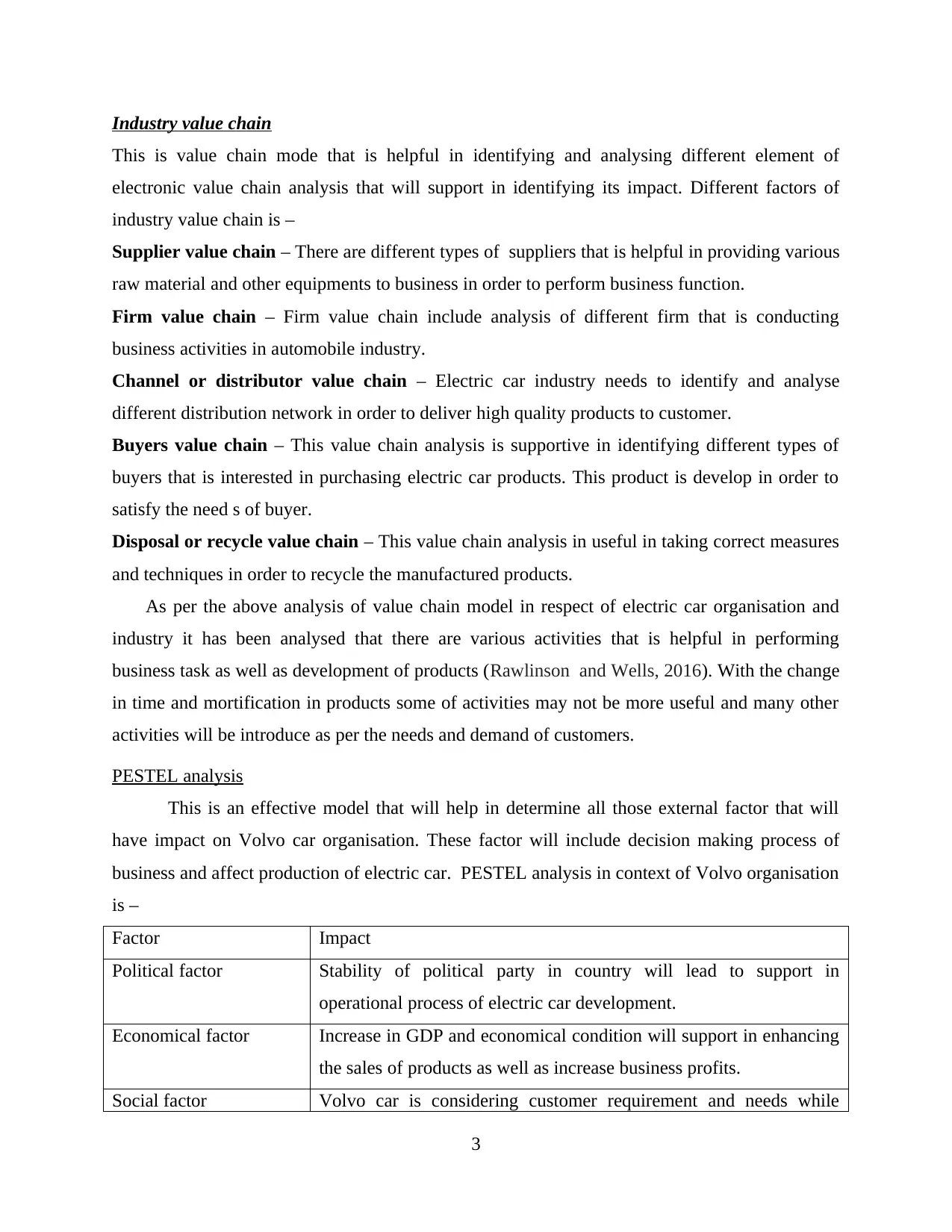
Industry value chain
This is value chain mode that is helpful in identifying and analysing different element of
electronic value chain analysis that will support in identifying its impact. Different factors of
industry value chain is –
Supplier value chain – There are different types of suppliers that is helpful in providing various
raw material and other equipments to business in order to perform business function.
Firm value chain – Firm value chain include analysis of different firm that is conducting
business activities in automobile industry.
Channel or distributor value chain – Electric car industry needs to identify and analyse
different distribution network in order to deliver high quality products to customer.
Buyers value chain – This value chain analysis is supportive in identifying different types of
buyers that is interested in purchasing electric car products. This product is develop in order to
satisfy the need s of buyer.
Disposal or recycle value chain – This value chain analysis in useful in taking correct measures
and techniques in order to recycle the manufactured products.
As per the above analysis of value chain model in respect of electric car organisation and
industry it has been analysed that there are various activities that is helpful in performing
business task as well as development of products (Rawlinson and Wells, 2016). With the change
in time and mortification in products some of activities may not be more useful and many other
activities will be introduce as per the needs and demand of customers.
PESTEL analysis
This is an effective model that will help in determine all those external factor that will
have impact on Volvo car organisation. These factor will include decision making process of
business and affect production of electric car. PESTEL analysis in context of Volvo organisation
is –
Factor Impact
Political factor Stability of political party in country will lead to support in
operational process of electric car development.
Economical factor Increase in GDP and economical condition will support in enhancing
the sales of products as well as increase business profits.
Social factor Volvo car is considering customer requirement and needs while
3
This is value chain mode that is helpful in identifying and analysing different element of
electronic value chain analysis that will support in identifying its impact. Different factors of
industry value chain is –
Supplier value chain – There are different types of suppliers that is helpful in providing various
raw material and other equipments to business in order to perform business function.
Firm value chain – Firm value chain include analysis of different firm that is conducting
business activities in automobile industry.
Channel or distributor value chain – Electric car industry needs to identify and analyse
different distribution network in order to deliver high quality products to customer.
Buyers value chain – This value chain analysis is supportive in identifying different types of
buyers that is interested in purchasing electric car products. This product is develop in order to
satisfy the need s of buyer.
Disposal or recycle value chain – This value chain analysis in useful in taking correct measures
and techniques in order to recycle the manufactured products.
As per the above analysis of value chain model in respect of electric car organisation and
industry it has been analysed that there are various activities that is helpful in performing
business task as well as development of products (Rawlinson and Wells, 2016). With the change
in time and mortification in products some of activities may not be more useful and many other
activities will be introduce as per the needs and demand of customers.
PESTEL analysis
This is an effective model that will help in determine all those external factor that will
have impact on Volvo car organisation. These factor will include decision making process of
business and affect production of electric car. PESTEL analysis in context of Volvo organisation
is –
Factor Impact
Political factor Stability of political party in country will lead to support in
operational process of electric car development.
Economical factor Increase in GDP and economical condition will support in enhancing
the sales of products as well as increase business profits.
Social factor Volvo car is considering customer requirement and needs while
3
⊘ This is a preview!⊘
Do you want full access?
Subscribe today to unlock all pages.

Trusted by 1+ million students worldwide
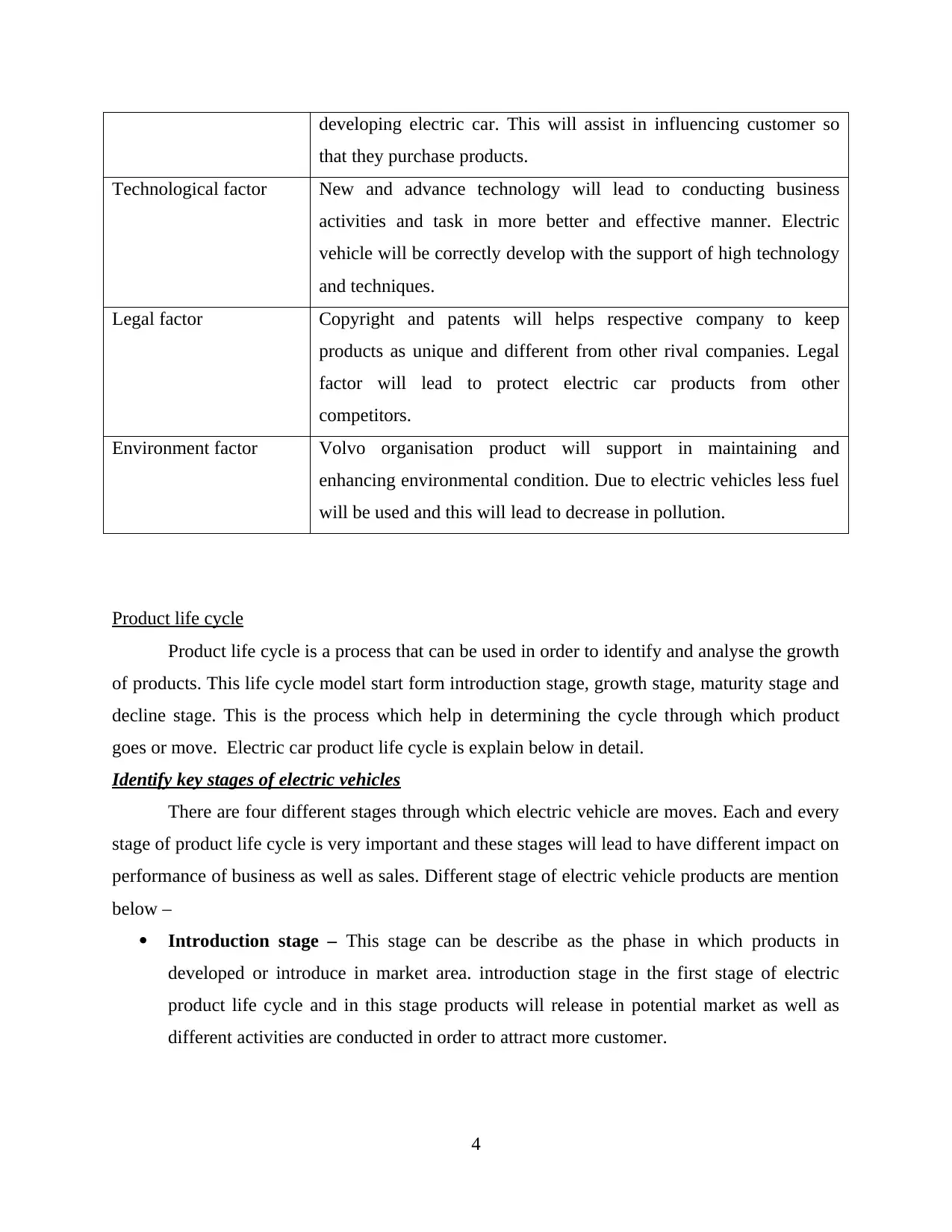
developing electric car. This will assist in influencing customer so
that they purchase products.
Technological factor New and advance technology will lead to conducting business
activities and task in more better and effective manner. Electric
vehicle will be correctly develop with the support of high technology
and techniques.
Legal factor Copyright and patents will helps respective company to keep
products as unique and different from other rival companies. Legal
factor will lead to protect electric car products from other
competitors.
Environment factor Volvo organisation product will support in maintaining and
enhancing environmental condition. Due to electric vehicles less fuel
will be used and this will lead to decrease in pollution.
Product life cycle
Product life cycle is a process that can be used in order to identify and analyse the growth
of products. This life cycle model start form introduction stage, growth stage, maturity stage and
decline stage. This is the process which help in determining the cycle through which product
goes or move. Electric car product life cycle is explain below in detail.
Identify key stages of electric vehicles
There are four different stages through which electric vehicle are moves. Each and every
stage of product life cycle is very important and these stages will lead to have different impact on
performance of business as well as sales. Different stage of electric vehicle products are mention
below –
Introduction stage – This stage can be describe as the phase in which products in
developed or introduce in market area. introduction stage in the first stage of electric
product life cycle and in this stage products will release in potential market as well as
different activities are conducted in order to attract more customer.
4
that they purchase products.
Technological factor New and advance technology will lead to conducting business
activities and task in more better and effective manner. Electric
vehicle will be correctly develop with the support of high technology
and techniques.
Legal factor Copyright and patents will helps respective company to keep
products as unique and different from other rival companies. Legal
factor will lead to protect electric car products from other
competitors.
Environment factor Volvo organisation product will support in maintaining and
enhancing environmental condition. Due to electric vehicles less fuel
will be used and this will lead to decrease in pollution.
Product life cycle
Product life cycle is a process that can be used in order to identify and analyse the growth
of products. This life cycle model start form introduction stage, growth stage, maturity stage and
decline stage. This is the process which help in determining the cycle through which product
goes or move. Electric car product life cycle is explain below in detail.
Identify key stages of electric vehicles
There are four different stages through which electric vehicle are moves. Each and every
stage of product life cycle is very important and these stages will lead to have different impact on
performance of business as well as sales. Different stage of electric vehicle products are mention
below –
Introduction stage – This stage can be describe as the phase in which products in
developed or introduce in market area. introduction stage in the first stage of electric
product life cycle and in this stage products will release in potential market as well as
different activities are conducted in order to attract more customer.
4
Paraphrase This Document
Need a fresh take? Get an instant paraphrase of this document with our AI Paraphraser
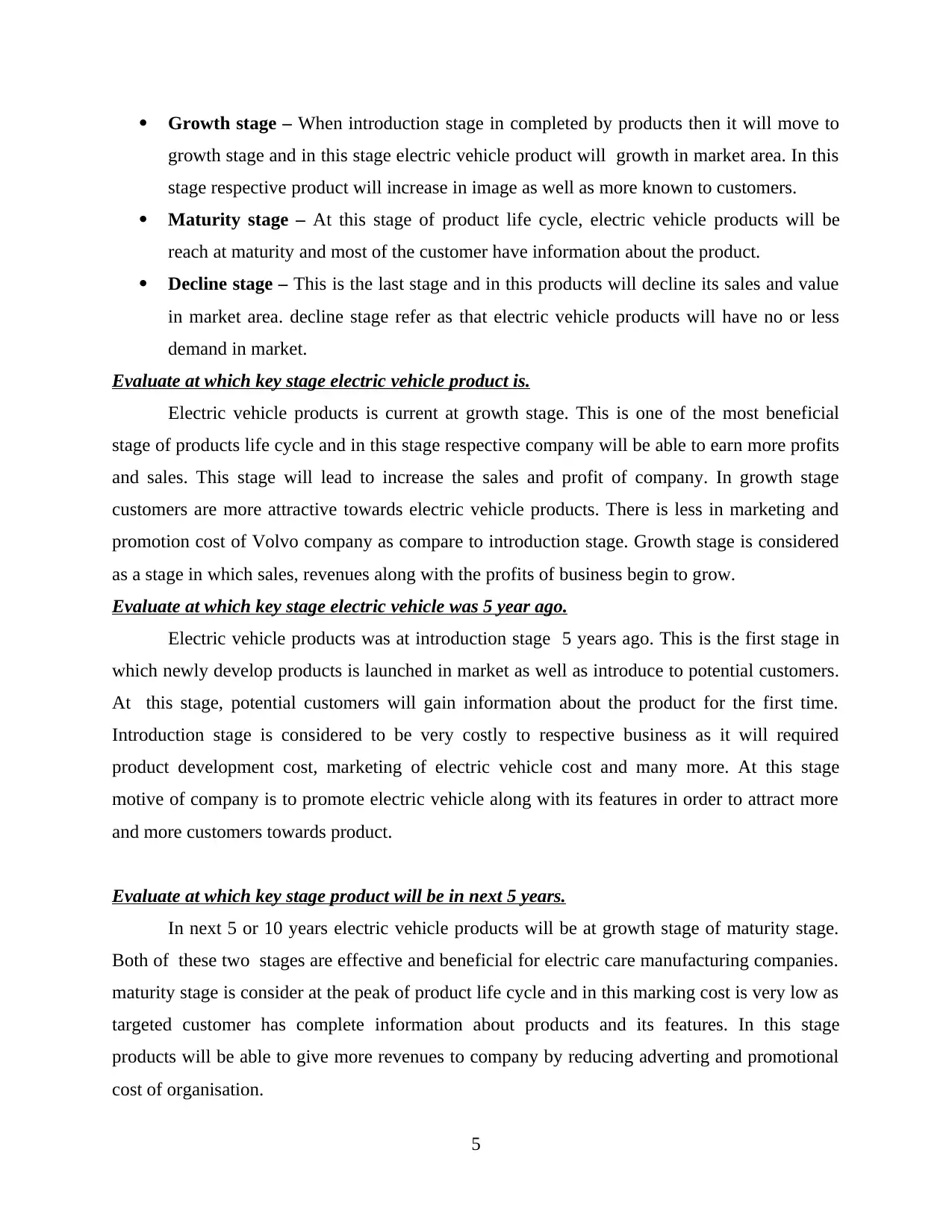
Growth stage – When introduction stage in completed by products then it will move to
growth stage and in this stage electric vehicle product will growth in market area. In this
stage respective product will increase in image as well as more known to customers.
Maturity stage – At this stage of product life cycle, electric vehicle products will be
reach at maturity and most of the customer have information about the product.
Decline stage – This is the last stage and in this products will decline its sales and value
in market area. decline stage refer as that electric vehicle products will have no or less
demand in market.
Evaluate at which key stage electric vehicle product is.
Electric vehicle products is current at growth stage. This is one of the most beneficial
stage of products life cycle and in this stage respective company will be able to earn more profits
and sales. This stage will lead to increase the sales and profit of company. In growth stage
customers are more attractive towards electric vehicle products. There is less in marketing and
promotion cost of Volvo company as compare to introduction stage. Growth stage is considered
as a stage in which sales, revenues along with the profits of business begin to grow.
Evaluate at which key stage electric vehicle was 5 year ago.
Electric vehicle products was at introduction stage 5 years ago. This is the first stage in
which newly develop products is launched in market as well as introduce to potential customers.
At this stage, potential customers will gain information about the product for the first time.
Introduction stage is considered to be very costly to respective business as it will required
product development cost, marketing of electric vehicle cost and many more. At this stage
motive of company is to promote electric vehicle along with its features in order to attract more
and more customers towards product.
Evaluate at which key stage product will be in next 5 years.
In next 5 or 10 years electric vehicle products will be at growth stage of maturity stage.
Both of these two stages are effective and beneficial for electric care manufacturing companies.
maturity stage is consider at the peak of product life cycle and in this marking cost is very low as
targeted customer has complete information about products and its features. In this stage
products will be able to give more revenues to company by reducing adverting and promotional
cost of organisation.
5
growth stage and in this stage electric vehicle product will growth in market area. In this
stage respective product will increase in image as well as more known to customers.
Maturity stage – At this stage of product life cycle, electric vehicle products will be
reach at maturity and most of the customer have information about the product.
Decline stage – This is the last stage and in this products will decline its sales and value
in market area. decline stage refer as that electric vehicle products will have no or less
demand in market.
Evaluate at which key stage electric vehicle product is.
Electric vehicle products is current at growth stage. This is one of the most beneficial
stage of products life cycle and in this stage respective company will be able to earn more profits
and sales. This stage will lead to increase the sales and profit of company. In growth stage
customers are more attractive towards electric vehicle products. There is less in marketing and
promotion cost of Volvo company as compare to introduction stage. Growth stage is considered
as a stage in which sales, revenues along with the profits of business begin to grow.
Evaluate at which key stage electric vehicle was 5 year ago.
Electric vehicle products was at introduction stage 5 years ago. This is the first stage in
which newly develop products is launched in market as well as introduce to potential customers.
At this stage, potential customers will gain information about the product for the first time.
Introduction stage is considered to be very costly to respective business as it will required
product development cost, marketing of electric vehicle cost and many more. At this stage
motive of company is to promote electric vehicle along with its features in order to attract more
and more customers towards product.
Evaluate at which key stage product will be in next 5 years.
In next 5 or 10 years electric vehicle products will be at growth stage of maturity stage.
Both of these two stages are effective and beneficial for electric care manufacturing companies.
maturity stage is consider at the peak of product life cycle and in this marking cost is very low as
targeted customer has complete information about products and its features. In this stage
products will be able to give more revenues to company by reducing adverting and promotional
cost of organisation.
5
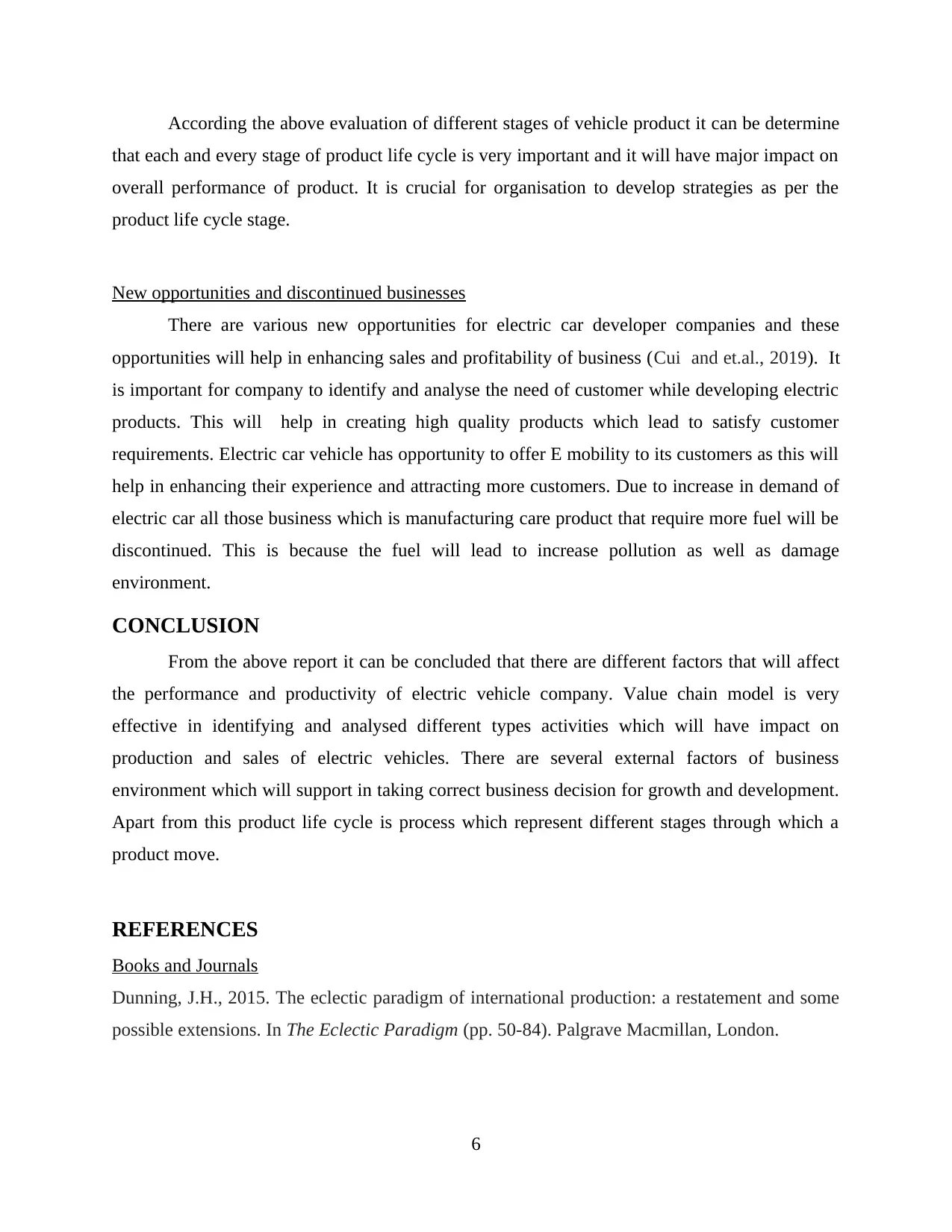
According the above evaluation of different stages of vehicle product it can be determine
that each and every stage of product life cycle is very important and it will have major impact on
overall performance of product. It is crucial for organisation to develop strategies as per the
product life cycle stage.
New opportunities and discontinued businesses
There are various new opportunities for electric car developer companies and these
opportunities will help in enhancing sales and profitability of business (Cui and et.al., 2019). It
is important for company to identify and analyse the need of customer while developing electric
products. This will help in creating high quality products which lead to satisfy customer
requirements. Electric car vehicle has opportunity to offer E mobility to its customers as this will
help in enhancing their experience and attracting more customers. Due to increase in demand of
electric car all those business which is manufacturing care product that require more fuel will be
discontinued. This is because the fuel will lead to increase pollution as well as damage
environment.
CONCLUSION
From the above report it can be concluded that there are different factors that will affect
the performance and productivity of electric vehicle company. Value chain model is very
effective in identifying and analysed different types activities which will have impact on
production and sales of electric vehicles. There are several external factors of business
environment which will support in taking correct business decision for growth and development.
Apart from this product life cycle is process which represent different stages through which a
product move.
REFERENCES
Books and Journals
Dunning, J.H., 2015. The eclectic paradigm of international production: a restatement and some
possible extensions. In The Eclectic Paradigm (pp. 50-84). Palgrave Macmillan, London.
6
that each and every stage of product life cycle is very important and it will have major impact on
overall performance of product. It is crucial for organisation to develop strategies as per the
product life cycle stage.
New opportunities and discontinued businesses
There are various new opportunities for electric car developer companies and these
opportunities will help in enhancing sales and profitability of business (Cui and et.al., 2019). It
is important for company to identify and analyse the need of customer while developing electric
products. This will help in creating high quality products which lead to satisfy customer
requirements. Electric car vehicle has opportunity to offer E mobility to its customers as this will
help in enhancing their experience and attracting more customers. Due to increase in demand of
electric car all those business which is manufacturing care product that require more fuel will be
discontinued. This is because the fuel will lead to increase pollution as well as damage
environment.
CONCLUSION
From the above report it can be concluded that there are different factors that will affect
the performance and productivity of electric vehicle company. Value chain model is very
effective in identifying and analysed different types activities which will have impact on
production and sales of electric vehicles. There are several external factors of business
environment which will support in taking correct business decision for growth and development.
Apart from this product life cycle is process which represent different stages through which a
product move.
REFERENCES
Books and Journals
Dunning, J.H., 2015. The eclectic paradigm of international production: a restatement and some
possible extensions. In The Eclectic Paradigm (pp. 50-84). Palgrave Macmillan, London.
6
⊘ This is a preview!⊘
Do you want full access?
Subscribe today to unlock all pages.

Trusted by 1+ million students worldwide
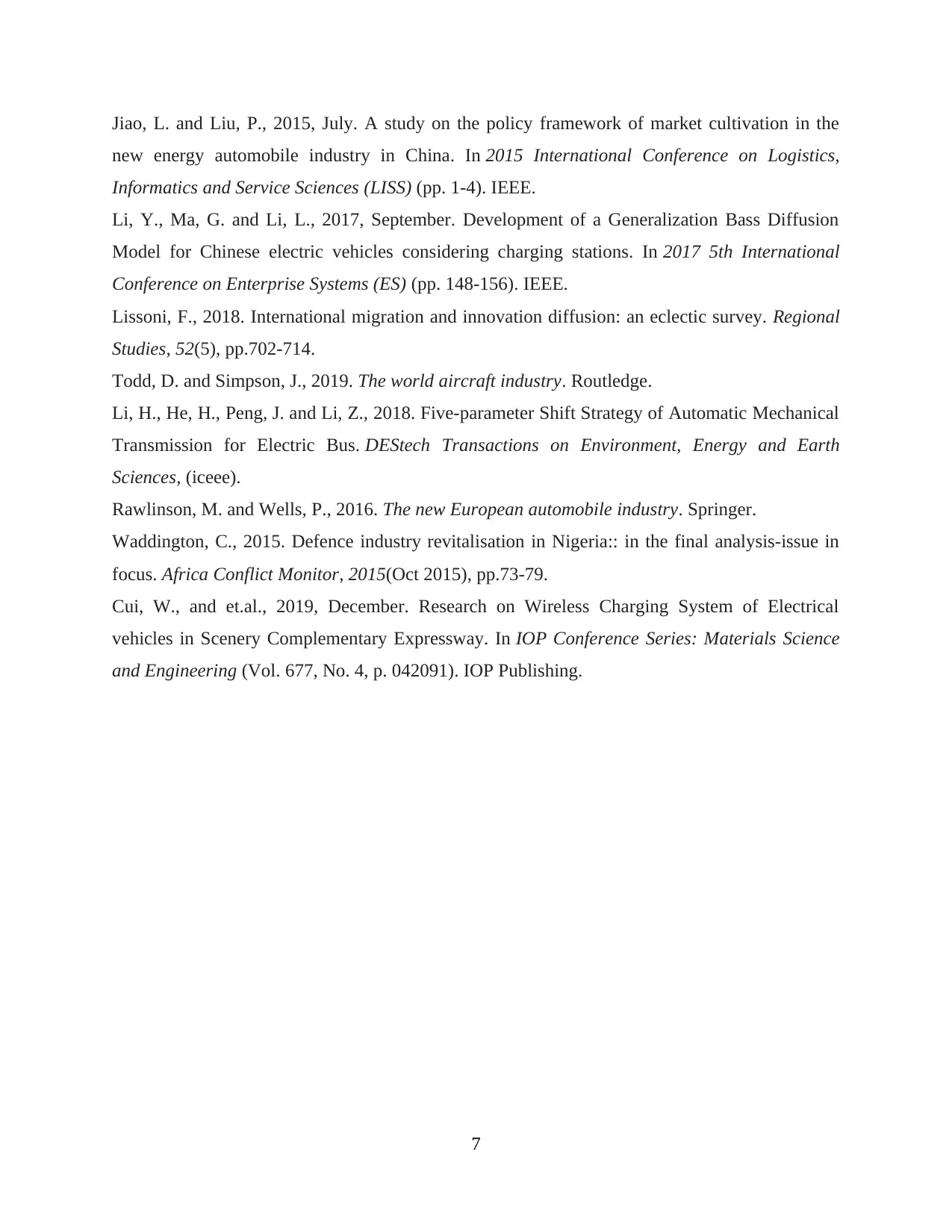
Jiao, L. and Liu, P., 2015, July. A study on the policy framework of market cultivation in the
new energy automobile industry in China. In 2015 International Conference on Logistics,
Informatics and Service Sciences (LISS) (pp. 1-4). IEEE.
Li, Y., Ma, G. and Li, L., 2017, September. Development of a Generalization Bass Diffusion
Model for Chinese electric vehicles considering charging stations. In 2017 5th International
Conference on Enterprise Systems (ES) (pp. 148-156). IEEE.
Lissoni, F., 2018. International migration and innovation diffusion: an eclectic survey. Regional
Studies, 52(5), pp.702-714.
Todd, D. and Simpson, J., 2019. The world aircraft industry. Routledge.
Li, H., He, H., Peng, J. and Li, Z., 2018. Five-parameter Shift Strategy of Automatic Mechanical
Transmission for Electric Bus. DEStech Transactions on Environment, Energy and Earth
Sciences, (iceee).
Rawlinson, M. and Wells, P., 2016. The new European automobile industry. Springer.
Waddington, C., 2015. Defence industry revitalisation in Nigeria:: in the final analysis-issue in
focus. Africa Conflict Monitor, 2015(Oct 2015), pp.73-79.
Cui, W., and et.al., 2019, December. Research on Wireless Charging System of Electrical
vehicles in Scenery Complementary Expressway. In IOP Conference Series: Materials Science
and Engineering (Vol. 677, No. 4, p. 042091). IOP Publishing.
7
new energy automobile industry in China. In 2015 International Conference on Logistics,
Informatics and Service Sciences (LISS) (pp. 1-4). IEEE.
Li, Y., Ma, G. and Li, L., 2017, September. Development of a Generalization Bass Diffusion
Model for Chinese electric vehicles considering charging stations. In 2017 5th International
Conference on Enterprise Systems (ES) (pp. 148-156). IEEE.
Lissoni, F., 2018. International migration and innovation diffusion: an eclectic survey. Regional
Studies, 52(5), pp.702-714.
Todd, D. and Simpson, J., 2019. The world aircraft industry. Routledge.
Li, H., He, H., Peng, J. and Li, Z., 2018. Five-parameter Shift Strategy of Automatic Mechanical
Transmission for Electric Bus. DEStech Transactions on Environment, Energy and Earth
Sciences, (iceee).
Rawlinson, M. and Wells, P., 2016. The new European automobile industry. Springer.
Waddington, C., 2015. Defence industry revitalisation in Nigeria:: in the final analysis-issue in
focus. Africa Conflict Monitor, 2015(Oct 2015), pp.73-79.
Cui, W., and et.al., 2019, December. Research on Wireless Charging System of Electrical
vehicles in Scenery Complementary Expressway. In IOP Conference Series: Materials Science
and Engineering (Vol. 677, No. 4, p. 042091). IOP Publishing.
7
1 out of 10
Related Documents
Your All-in-One AI-Powered Toolkit for Academic Success.
+13062052269
info@desklib.com
Available 24*7 on WhatsApp / Email
![[object Object]](/_next/static/media/star-bottom.7253800d.svg)
Unlock your academic potential
Copyright © 2020–2025 A2Z Services. All Rights Reserved. Developed and managed by ZUCOL.





